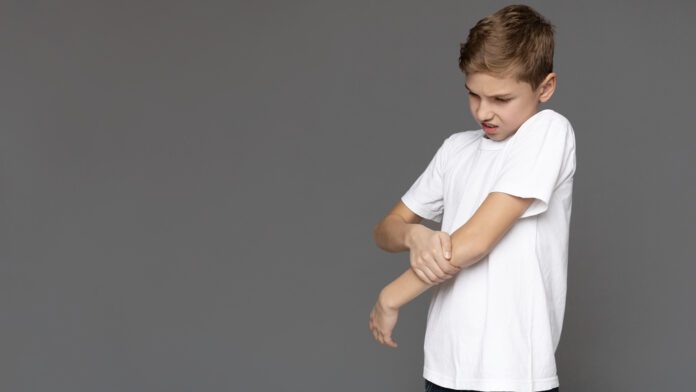Overview of Juvenile Idiopathic Arthritis
Juvenile Idiopathic Arthritis (JIA) is a term used to describe a group of disorders in children that include arthritis. They are long-term (chronic) diseases that cause joint pain and swelling. The names describing this group of conditions has changed over the past several decades as more is learned about the condition.
Commonly Associated With
Juvenile rheumatoid arthritis (JRA); Juvenile chronic polyarthritis; Still disease; Juvenile spondyloarthritis
Cause of Juvenile Idiopathic Arthritis
The cause of JIA is not known. It is thought to be an autoimmune illness. This means the body attacks and destroys healthy body tissue by mistake.
JIA most often develops before age 16. Symptoms may start as early as 6 months old.
The International League of Associations for Rheumatology (ILAR) has proposed the following way of grouping this type of childhood arthritis:
Systemic-onset JIA. Involves joint swelling or pain, fevers, and rash. It is the least common type but it can be the most severe. It appears to be different than the other types of JIA and is similar to Adult Onset Stills Disease.
Polyarthritis. Involves many joints. This form of JIA may turn into rheumatoid arthritis. It may involve 5 or more large and small joints of the legs and arms, as well as the jaw and neck. Rheumatoid factors may be present.
Oligoarthritis (persistent and extended). Involves 1 to 4 joints, most often the wrists, or knees. It also affects the eyes.
Enthesitis-related arthritis. Resembles spondyloarthritis in adults and often involves the sacroiliac joint.
Psoriatic arthritis. Diagnosed in children who have arthritis and psoriasis or nail disease, or a have close family member with psoriasis.
Symptoms of Juvenile Idiopathic Arthritis
Symptoms of JIA may include:
Swollen, red, or warm joint
Limping or problems using a limb
Sudden high fever, which may come back
Rash (on trunk and extremities) that comes and goes with fever
Stiffness, pain, and limited movement of a joint
Low back pain that does not go away
Bodywide symptoms such as pale skin, swollen lymph gland, and a sick appearance
JIA can also cause eye problems called uveitis, iridocyclitis, or iritis. There may be no symptoms. When eye symptoms occur, they can include:
Red eyes
Eye pain, which may get worse when looking at light (photophobia)
Vision changes
Exams & Tests for Juvenile Idiopathic Arthritis
The physical exam may show swollen, warm, and tender joints that hurt to move. The child may have a rash. Other signs include:
Swollen liver
Swollen spleen
Swollen lymph nodes
Blood tests may include:
Rheumatoid factor
Erythrocyte sedimentation rate (ESR)
Antinuclear antibody (ANA)
Complete blood count (CBC)
HLA-B27
Any or all of these blood tests may be normal in children with JIA.
The health care provider may place a small needle into a swollen joint to remove the fluid. This can help to find the cause of arthritis. It can also help relieve pain. The provider may inject steroids into the joint to help reduce swelling.
Other tests that may be done include:
X-ray of a joint
Bone scan
X-ray of the chest
ECG
A regular eye exam by an ophthalmologist — should be done even if there are no eye symptoms.
Treatment for Juvenile Idiopathic Arthritis
Nonsteroidal anti-inflammatory drugs (NSAIDs) such as ibuprofen or naproxen may be enough to control symptoms when only a small number of joints are involved.
Corticosteroids may be used for more severe flare-ups to help control symptoms. Because of their toxicity, long-term use of these medicines should be avoided in children.
Children who have arthritis in many joints, or who have a fever, rash, and swollen glands may need other medicines. These are called disease-modifying antirheumatic drugs (DMARDs).
They can help reduce swelling in the joints or body. DMARDs include:
Methotrexate
Biologic drugs, such as etanercept (Enbrel), infliximab (Remicade), and related drugs
Children with systemic JIA will likely need biologic inhibitors of IL-1 or IL-6 such as anakinra or tocilizumab.
Children with JIA need to stay active.
Exercise will help keep their muscles and joints strong and mobile.
Walking, bicycling, and swimming may be good activities.
Children should learn to warm up before exercising.
Talk to the doctor or physical therapist about exercises to do when your child is having pain.
Children who have sadness or anger about their arthritis may need extra support.
Some children with JIA may need surgery, including joint replacement.
Source
https://www.cdc.gov/arthritis/basics/childhood.htm
https://www.niams.nih.gov/health-topics/juvenile-arthritis



